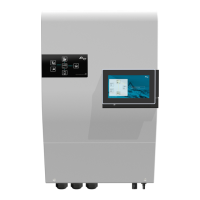Studer Innotec SA
next3
Technical user manual V1.3 © Studer-Innotec SA 31
5.2.4
Earthing of battery
One of the two battery conductors can be earthed. This may be either the positive or the negative
pole as the battery is isolated from the other potentials (PV, AC). In all cases, the installation must be
conform to the local regulations and usage or specific standards associated with the application.
In case of earthing, the earthing conductor cross-section must at least be equivalent to the cross-
section of the battery conductor. The earthing of the equipment must also adhere to these
regulations. For this case, use the additional earthing screws, which are located at the bottom of the
device under the AC cabling glands.
All the other earthing systems (earthing by means of a protection device, impedance,
without earthing or earthed at battery positive pole) require the whole battery circuit to be
protected against electric shocks.
Any accidental contact with the conductive parts of the battery circuit is to be avoided by providing
a Class II protection level.
5.2.5
Precautions when using batteries
The batteries should only be chosen, dimensioned, and installed by qualified personnel. Lead-
acid batteries with liquid or gelled electrolyte produce a highly explosive gas during normal
use. Other special types of batteries present similar risks. Avoid source of sparks or fire in the
immediate vicinity of the batteries. The batteries must be kept in a well-ventilated place and
installed to avoid accidental short-circuits when connecting.
Never try to charge frozen batteries. When working with batteries, a second person is required
to give assistance in case of problems.
Fresh water and soap must be kept close at hand to allow adequate and immediate washing
of the skin or eyes affected by accidental contact with the battery acid. In the event of
accidental contact of the eyes with acid, they must be washed carefully with cold water for
15 minutes. Then immediately consult a doctor.
Care is required when working close to the batteries with metal tools. Tools such as
screwdrivers, open-ended spanners, etc., may cause short circuits. Sparks created by short-
circuits may cause the battery to explode. Therefore, these kinds of tools must always have
isolated handles and never be placed on top of a battery. When working with the batteries,
all metal jewellery such as rings, watches with a metal bracelet, earrings, etc., must be taken
off. The current supplied by the batteries during a short circuit is sufficiently powerful to melt
the metal and cause severe burns.
Batteries at the end of their life cycle should be recycled in accordance with directives from
the responsible local authorities or the battery supplier. The batteries should never be thrown
into fire as they may explode. Under no circumstances should you try to take apart or
dismount the battery, as they contain toxic and polluting materials. For ungrounded battery
systems, always check that they are not inadvertently grounded before starting to work on
the batteries.
Always carefully follow the instructions of the battery manufacturer.

